
KDS Consulting, USA
KDS Consulting provided services for storing paper and digital archives for companies dealing with large volumes of handwritten documentation, such as medical institutions, law firms, etc. Organizations would submit materials and specify the storage system, after which KDS Consulting's representatives would scan them. KDS Consulting charged a fee for digitization and cloud storage with client access, with the cost depending on the data volume.
Before reaching out to us, requests were accepted via email or phone.
Create a platform for parsing and storing documentation on the server to implement solutions that cover the entire document lifecycle, from inception to physical destruction, as comprehensively as possible.
A web-based platform has been developed to systematize scanned documents, aiding in structuring archives and facilitating sharing with colleagues.
ReliaDocs is a sophisticated solution aimed at digitizing documentation processes.

Design and planning
(3-4 weeks)
We conducted a brainstorming session to define the system roles and customer journeys (CJM).
We created user scenarios (User Stories).
We calculated the infrastructure costs, considering the expected loads.
We prepared and documented the project architecture plan.
We estimated the scope of work, assigned priorities to functionalities, and developed the project roadmap, determining the optimal team composition.
We prepared the budget.
Development Stage
(12 weeks)
Release 1: Key functionality of the platform
Release 2: Additional functionality of the platform
Support Stage
Clients can create libraries according to their needs, set up folders, and configure the naming of future files. The application integrates with scanners, enabling users to scan thousands of documents in a short period and automatically distribute them into specific folders based on settings.
User Roles
The Customer accesses the platform and gains entry to libraries. Inside these libraries, there are directories with folders and subfolders. Each folder includes information about when it was created and how many files it contains.
The customer can view reference information about a file (upload date, modification date, manager's name) and, upon clicking on a specific file, a list of related pages appears in the form of previews.

A flexible access management system has been created, allowing clients to share data for reading via email (without editing capabilities) with other company participants, as well as upload files.

Within the system, there is a file editor available, enabling users to delete and download pages.
Additionally, a two-way document upload feature has been implemented: by the administrator or by the client's representative themselves.
There is also the ability to add fields in the library. A preview is available for each document.

The Company Manager digitizes and uploads all archives.
The Global Administrator has access to all client accounts and archives.
There is also a notifications block in the application. It contains all major user notifications (editing, deleting, sharing libraries, successful document batching, etc.).
The application also includes a tool for systematization called a separator.
A separator is a page with a barcode used to divide document pages into folders. When uploaded, the software detects the separator and automatically groups all pages between it and the next separator into the specified folder. This folder is determined by the barcode on the separator.

Due to the large volume of information, infrastructure refinement was required to provide the client with optimal storage conditions.
The implementation of the application for the customer's clients represented a significant competitive advantage.
By utilizing the application, companies were able to free up part of employees' workdays and also eliminate costs associated with processing, storing, and sending paper documents, thereby increasing operational efficiency.